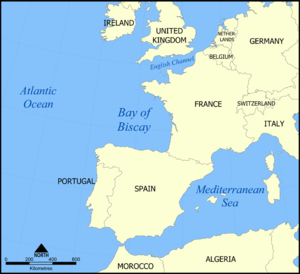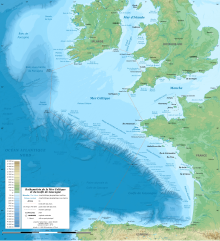| Revision as of 19:54, 22 February 2015 editIñaki LL (talk | contribs)Extended confirmed users11,820 edits →Name: Disambiguation← Previous edit | Revision as of 12:21, 16 March 2015 edit undoGamera1123 (talk | contribs)2,211 edits →External linksNext edit → | ||
| Line 73: | Line 73: | ||
| ==External links== | ==External links== | ||
| * {{Cite NSRW|short=x|wstitle=Biscay, Bay of}} | * {{Cite NSRW|short=x|wstitle=Biscay, Bay of}} | ||
| * {{Cite web|url=http://www.eoearth.org/view/article/51cbed0c7896bb431f68f4e1/|title=Bay of Biscay - The Encyclopedia of Earth}} | |||
| {{List of seas}} | {{List of seas}} | ||
Revision as of 12:21, 16 March 2015

The Bay of Biscay /ˈbɪskeɪ, -ki/ (Template:Lang-es, Template:Lang-fr) is a gulf of the northeast Atlantic Ocean located south of the Celtic Sea. It lies along the western coast of France from Brest south to the Spanish border, and the northern coast of Spain west to Cape Ortegal.
The average depth is 1,744 metres (5,722 ft) and the greatest depth is 4,735 metres (15,535 ft).
Name
The Bay of Biscay is named (for English speakers) after Biscay on the northern Spanish coast, probably standing for the western Basque districts (Biscay up to the early 19th century). Its name in other languages is:
- Template:Lang-eu
- Template:Lang-es; also Error: {{Lang}}: text has italic markup (help) for the ocean area closer to the Spanish coast, the "Cantabrian Sea"
- Template:Lang-fr (named after Gascony, France)
- Template:Lang-br
- Gascon: Golf de Gasconha
Geography




Parts of the continental shelf extend far into the bay, resulting in fairly shallow waters in many areas and thus the rough seas for which the region is known. The Bay of Biscay is home to some of the Atlantic Ocean's fiercest weather. Large storms occur in the bay, especially during the winter months. Up until recent years it was a regular occurrence for merchant vessels to founder in Biscay storms.
Extent
The International Hydrographic Organization defines the limits of the Bay of Biscay as "a line joining Cap Ortegal (43°46′N 7°52′W / 43.767°N 7.867°W / 43.767; -7.867) to Penmarch Point (47°48′N 4°22′W / 47.800°N 4.367°W / 47.800; -4.367)".
Rivers
The main rivers that empty into the Bay of Biscay are Loire, Charente, Garonne, Dordogne, Adour, Nivelle, Bidasoa, Oiartzun, Urumea, Oria, Urola, Deba, Artibai, Oka, Nervión, Agüera, Asón, Miera, Pas, Saja, Nansa, Deva, Sella, Nalón, Navia, Esva, Eo, Landro and Sor.
Climate
The phenomenon of June Gloom is common. In late spring and early summer a large fog triangle fills the southwestern half of the bay, covering just a few kilometres inland.
As winter begins, weather becomes severe. Depressions enter from the west very frequently and they either bounce north to the British Isles or they enter the Ebro Valley, dry out, and are finally reborn in the form of powerful thunderstorms as they reach the Mediterranean Sea. These depressions cause severe weather at sea and bring light though very constant rain to its shores (known as orballo, sirimiri, morrina, orbayu and orpin (in Asturias) or calabobos in northern Spain). Sometimes powerful windstorms form if the pressure falls rapidly, traveling along the Gulf Stream at great speed, resembling a hurricane, and finally crashing in this bay with their maximum power, such as the Klaus storm.
The Gulf Stream enters the bay following the continental shelf's border anti-clockwise (the Rennell Current), keeping temperatures moderate all year long.
Main cities
The main cities on the shores of the Bay of Biscay are Bordeaux, Bayonne, Biarritz, Brest, Nantes, La Rochelle, Donostia-San Sebastián, Bilbao, Santander, Gijón and Avilés.
History
The southern end of the gulf is also called in Spanish "Mar Cantábrico" (Cantabrian Sea), from the Estaca de Bares, as far as the mouth of Adour river, but this name is not generally used in English. It was named by Romans in the 1st century BC as Sinus Cantabrorum (Bay of the Cantabri) and more frequently, Mare Gallaecum (the Sea of the Galicians). On some medieval maps, the Bay of Biscay is marked as El Mar del los Vascos (the Basque Sea).
The Bay of Biscay has been the site of many famous naval engagements over the centuries. In 1592 the Spanish defeated an English fleet during the eponymous Battle of the Bay of Biscay. The Biscay campaign of June 1795 consisted of a series of manoeuvres and two battles fought between the British Channel Fleet and the French Atlantic Fleet off the southern coast of Brittany during the second year of the French Revolutionary Wars. The USS Californian sunk here after striking a naval mine on June 22, 1918. On December 28, 1943, the Battle of the Bay of Biscay was fought between HMS Glasgow and HMS Enterprise and a group of German destroyers as part of Operation Stonewall during World War II.
Wildlife

Marine mammals
The car ferries from Gijón to Nantes/Saint-Nazaire, Portsmouth to Bilbao and from Plymouth, Portsmouth and Poole to Santander provide one of the most convenient ways to see cetaceans in European waters. Often specialist groups take the ferries to hear more information.
Volunteers and employees of Biscay Dolphin Research regularly observe and monitor cetacean activity from the bridge of the ships on the P&O Ferries Portsmouth to Bilbao route. Many species of whales and dolphins can be seen in this area. Most importantly, it is one of the few places where the beaked whales, such as the Cuvier's beaked whale, have been observed relatively frequently. This is the best study area in the world for beaked whales.
North Atlantic Right Whales, one of the most endangered whales, once came to the bay for feeding and probably for calving as well, but whaling activities by Basques and others almost wiped them out sometime prior to 1850s. In modern days, the eastern population of this species are considered to be almost extinct, and there has been no record of right whales in the Bay of Biscay except for possible few sightings made in modern time, a pair which was possibly a mother-calf pair in 1977 at 43°00′N 10°30′W / 43.000°N 10.500°W / 43.000; -10.500, and another pair in earlier June 1980 seen by merchantmen. Other records in the late 20th century include one off Galicia at 43°00′N 10°30′W / 43.000°N 10.500°W / 43.000; -10.500 in September 1977 reported by a whaling company and another one seen off the Iberian Peninsula.
The best areas to see the larger cetaceans lie in the deep waters beyond the continental shelf, particularly over the Santander Canyon and Torrelavega Canyon in the south of the Bay.
The three-day round trip also gives sightings of good numbers of several species of seabirds, particularly gannets.
The alga Colpomenia peregrina was introduced and first noticed in 1906 by oyster fishermen in the Bay of Biscay.
The Grammatostomias flagellibarba commonly known as the scaleless dragonfish are native to these waters.
See also
References
- "Bay of Biscay".
- "Limits of Oceans and Seas, 3rd edition + corrections" (PDF). International Hydrographic Organization. 1971. p. 42 . Retrieved 6 February 2010.
- "El mar de los vascos, II: del Golfo de Vizcaya al Mediterráneo" (PDF).
- "USS Californian (1918-1918)".
- Reeves, R.R. and Mitchell, E. (1986). "American pelagic whaling for right whales in the North Atlantic" (PDF). Report of the International Whaling Commission (Special Issue 10): 221–254. Retrieved 2013-10-09.
{{cite journal}}: CS1 maint: multiple names: authors list (link) - http://www.fishbase.us/summary/Grammatostomias-flagellibarba.html
External links
- "Biscay, Bay of" . The New Student's Reference Work . 1914.
- "Bay of Biscay - The Encyclopedia of Earth".
45°30′N 04°20′W / 45.500°N 4.333°W / 45.500; -4.333
Categories: